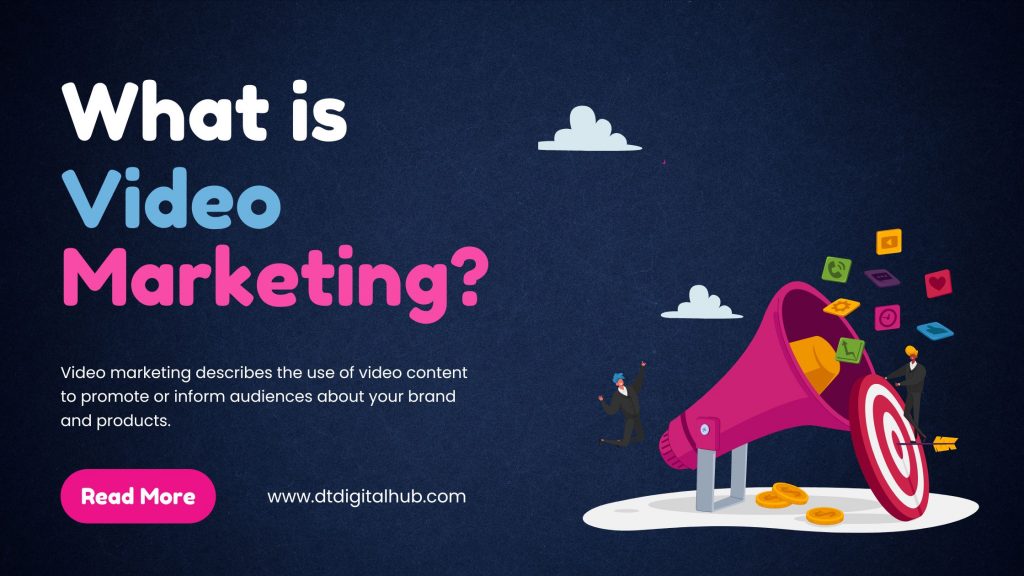Video marketing is a digital marketing strategy that uses videos to promote products, services, or brands. It involves creating and distributing videos through various online platforms such as social media, video-sharing websites, and email marketing campaigns. Video marketing can be used for various purposes, such as educating customers about a product, showcasing a brand’s personality, or building brand awareness.
Videos can come in various formats, such as explainer videos, product demos, customer testimonials, behind-the-scenes videos, and promotional videos. They can be short or long, live-action or animated, and can be optimized for different platforms and audiences.
Video marketing has become increasingly popular in recent years due to the growing use of mobile devices and the rise of video-sharing platforms such as YouTube and TikTok. It has proven to be an effective way to engage with customers, increase brand awareness, and drive conversions.
How Video Marketing Works
Video marketing involves creating and sharing video content to promote a business’s products or services. Here are the basic steps involved in how video marketing works:
- Plan: Determine your marketing goals and target audience. Develop a video marketing strategy that aligns with your objectives and audience preferences.
- Create: Develop a script and storyboard for your video. Choose the type of video that best suits your content and message, such as product demos, explainer videos, or testimonials. Consider hiring a professional videographer or using video editing software to create high-quality videos.
- Publish: Publish your video on your website, social media channels, and other online platforms. Optimize your video for search engines by including relevant keywords, titles, descriptions, and tags.
- Promote: Promote your video through paid advertising, email marketing, social media marketing, and other channels to increase visibility and reach your target audience.
- Analyze: Monitor your video’s performance metrics, such as views, engagement, and conversions. Use this data to adjust your video marketing strategy and improve your results over time.
Video marketing can be an effective way to engage your audience, build brand awareness, and drive conversions. By following these basic steps, businesses can create and share compelling video content that resonates with their audience and achieves their marketing goals.
Types of Video Marketing
There are several types of video marketing that businesses can use to reach their target audience and achieve their marketing goals. Here are some of the most common types of video marketing:
- Explainer videos: Explainer videos are short, animated videos that explain a product or service in a simple and engaging way.
- Product demos: Product demo videos showcase the features and benefits of a product and help customers understand how to use it.
- Customer testimonials: Customer testimonial videos feature real customers sharing their positive experiences with a product or service, which can help build trust and credibility.
- Brand videos: Brand videos tell the story of a brand and its values, and can help build brand awareness and loyalty.
- Live videos: Live videos are streamed in real-time and allow businesses to connect with their audience in a more authentic and engaging way.
- How-to videos: How-to videos provide step-by-step instructions on how to perform a task or solve a problem, and can be used to educate customers about a product or service.
- Animated videos: Animated videos use graphics, illustrations, and animation to explain complex ideas or concepts in a simple and engaging way.
- Social media videos: Social media videos are short, attention-grabbing videos designed to be shared on social media platforms such as Facebook, Instagram, and Twitter.
By using a mix of these video marketing types, businesses can create a comprehensive video marketing strategy that engages their audience, builds brand awareness, and drives conversions.
Fundamentals of video marketing
Video marketing can be an effective tool for businesses to reach their target audience and achieve their marketing goals. Here are some fundamental principles of video marketing:
- Understand your audience: Before creating any video content, it’s essential to understand your target audience. This includes their demographics, interests, pain points, and preferences.
- Set clear objectives: Define your marketing goals and create a plan to achieve them. Your objectives could include building brand awareness, generating leads, increasing sales, or educating your audience.
- Create engaging content: Create videos that capture your audience’s attention and keep them engaged. Use storytelling techniques, humor, and emotion to make your content more memorable and shareable.
- Optimize for different platforms: Different platforms have different video requirements and specifications. Optimize your videos for each platform to ensure they are displayed correctly and effectively.
- Use calls-to-action: Include calls-to-action in your videos to encourage your audience to take a specific action, such as visiting your website, subscribing to your channel, or making a purchase.
- Analyze and adjust: Analyze your video performance metrics, such as views, engagement, and conversions. Use this data to adjust your video marketing strategy and improve your results over time.
By following these fundamentals of video marketing, businesses can create effective and engaging video content that resonates with their target audience and drives their marketing goals.
Video marketing examples
There are many great examples of video marketing that businesses have used to promote their products or services. Here are a few examples:
- Dollar Shave Club: This company’s viral video features its CEO explaining the benefits of its shaving products in a humorous and engaging way. The video helped the company gain millions of subscribers and was instrumental in its acquisition by Unilever.
- Old Spice: Old Spice’s “The Man Your Man Could Smell Like” campaign featured humorous, over-the-top videos that helped the brand appeal to a younger audience and increase its market share.
- Apple: Apple’s product launch events are examples of masterful video marketing. The company uses high-quality videos to showcase its products and build hype around new releases.
- Blendtec: Blendtec’s “Will it Blend?” video series features its CEO blending unusual items such as iPhones and golf balls to demonstrate the power of its blenders. The videos went viral and helped the company increase sales and brand awareness.
- Nike: Nike’s “Dream Crazy” campaign features a video narrated by Colin Kaepernick that highlights the company’s support for social justice and encourages viewers to dream big. The campaign received widespread acclaim and helped Nike increase its sales and brand loyalty.
These examples show how businesses can use video marketing to engage their audience, build brand awareness, and drive sales.
Why is video marketing important?
Video marketing is important for several reasons:
- Increases engagement: Video is a highly engaging medium that can capture the viewer’s attention and keep them interested in your content. It allows businesses to communicate their message in a more dynamic and impactful way than text or images alone.
- Builds trust: Video marketing can help businesses build trust with their audience by showcasing their products, services, or expertise in an authentic and transparent way. It can help humanize the brand and establish a personal connection with the viewer.
- Increases brand awareness: Video marketing can help businesses increase their brand awareness by reaching a wider audience and generating more shares and likes on social media. It can also help businesses stand out in a crowded marketplace and differentiate themselves from competitors.
- Boosts conversions: Video marketing can help businesses drive conversions by providing more information about their products or services and addressing common questions or objections that potential customers may have.
- Improves SEO: Video can help improve a business’s search engine rankings by increasing the time users spend on the website, reducing bounce rates, and increasing engagement.
Overall, video marketing is a powerful tool that businesses can use to achieve their marketing goals and connect with their target audience in a more meaningful way.
video marketing statistics
Here are some key video marketing statistics:
- Video is one of the most popular forms of online content, with 85% of internet users in the United States watching videos online regularly. (Source: Statista)
- The average person spends 100 minutes per day watching online videos. (Source: Wyzowl)
- Video can be a highly effective tool for generating leads and driving conversions. According to HubSpot, including video on a landing page can increase conversion rates by up to 80%.
- Social media platforms such as Facebook, Instagram, and Twitter have become increasingly popular for video marketing, with video content generating up to 1200% more shares than text and image-based content combined. (Source: G2)
- Mobile video consumption is on the rise, with mobile users watching an average of 40 minutes of video per day. (Source: Oberlo)
- Live video is becoming an increasingly popular format for marketers, with 80% of consumers saying they would rather watch a live video from a brand than read a blog post. (Source: Livestream)
Overall, these statistics show that video marketing can be a highly effective tool for engaging with audiences, generating leads, and driving conversions in the digital age.
what is video marketing strategy
A video marketing strategy is a plan that outlines how a business will use video content to achieve its marketing goals. A successful video marketing strategy should align with the business’s overall marketing objectives and target audience preferences. Here are the key components of a video marketing strategy:
- Define your objectives: Determine the marketing objectives you want to achieve with video marketing, such as increasing brand awareness, generating leads, driving conversions, or improving customer engagement.
- Understand your target audience: Identify your target audience’s preferences, needs, and pain points. Determine what type of video content will resonate with them and how they prefer to consume video content.
- Choose the right video format: Determine the type of video content that aligns with your marketing goals and target audience preferences, such as product demos, testimonials, explainer videos, or behind-the-scenes footage.
- Develop a content plan: Create a content plan that outlines the topics, themes, and messages you want to convey through your video content. Determine the frequency and distribution channels for your video content.
- Optimize your videos for search engines: Use keywords, titles, descriptions, and tags to optimize your video content for search engines and increase visibility.
- Promote your videos: Use a mix of paid and organic promotion tactics to distribute your video content, such as social media advertising, email marketing, influencer outreach, and video SEO.
- Measure and optimize: Track and analyze the performance metrics of your video content, such as views, engagement, and conversions. Use this data to adjust your video marketing strategy and improve your results over time.
A well-planned video marketing strategy can help businesses achieve their marketing objectives, increase engagement with their target audience, and drive conversions.
what is video marketing trends
Video marketing trends refer to the evolving best practices, techniques, and technologies that businesses use to create, distribute, and measure the impact of their video content. Here are some of the current video marketing trends:
- Interactive videos: Interactive videos enable viewers to engage with the content by clicking on hotspots, making choices, or taking actions that affect the outcome of the video.
- Live streaming: Live streaming is the process of broadcasting video content in real-time through online platforms such as Facebook, Instagram, or YouTube. This trend allows businesses to connect with their audience in a more authentic and engaging way.
- Short-form videos: Short-form videos are brief, snackable pieces of content that capture the viewer’s attention quickly and convey a message efficiently. This trend is particularly popular on social media platforms such as TikTok and Instagram.
- Personalized videos: Personalized videos are customized for each viewer, based on their preferences and behavior. This trend allows businesses to create a more relevant and engaging video experience for their audience.
- 360-degree videos: 360-degree videos provide an immersive, interactive experience that allows viewers to explore a scene from multiple angles. This trend is particularly popular in the tourism and real estate industries.
- Vertical videos: Vertical videos are shot in a portrait orientation, rather than landscape, which is more conducive to mobile viewing. This trend is particularly popular on social media platforms such as Instagram and Snapchat.
- Video SEO: Video SEO is the practice of optimizing video content for search engines by using relevant keywords, titles, descriptions, and tags. This trend is becoming increasingly important as video consumption continues to grow.
By staying up-to-date with the latest video marketing trends, businesses can create more engaging, effective video content that resonates with their audience and achieves their marketing objectives.
Benefits of Video Marketing
Video marketing has numerous benefits for businesses, including:
- Increased engagement: Videos are more engaging than text or images alone, as they combine visual and auditory elements to capture the viewer’s attention and evoke emotions.
- Improved brand awareness: Video marketing helps businesses reach a wider audience and increase brand awareness through social media sharing and word-of-mouth marketing.
- Enhanced customer experience: Videos provide a more immersive and interactive customer experience, which can improve customer satisfaction and loyalty.
- Higher conversion rates: Videos can help businesses convert more leads into customers, as they can showcase products or services in a more compelling and informative way.
- Improved SEO: Video content is more likely to rank higher in search engine results, as it can increase dwell time, reduce bounce rates, and generate more backlinks.
- Better ROI: Video marketing can be a cost-effective way to achieve marketing objectives, as it can reach a wider audience and generate higher conversion rates than other marketing tactics.
- Increased social media engagement: Videos are more likely to be shared on social media than text or images alone, which can increase social media engagement and reach.
Overall, video marketing can help businesses build brand awareness, improve customer experience, and increase conversion rates, leading to better business outcomes and ROI.
what is video marketing software
Video marketing software refers to a suite of tools and platforms that businesses can use to create, edit, manage, and distribute video content for their marketing campaigns. Here are some common types of video marketing software:
- Video editing software: These tools allow businesses to create and edit video content, such as adding text, music, transitions, and effects. Examples of video editing software include Adobe Premiere, Final Cut Pro, and iMovie.
- Video hosting platforms: These platforms provide businesses with a place to upload and store their video content, as well as embed videos on their website or social media channels. Examples of video hosting platforms include YouTube, Vimeo, and Wistia.
- Video analytics software: These tools provide businesses with insights into the performance of their video content, such as views, engagement, and conversion rates. Examples of video analytics software include Vidyard, Brightcove, and SproutVideo.
- Video creation platforms: These platforms provide businesses with a suite of tools to create video content, including pre-made templates, stock footage, and editing tools. Examples of video creation platforms include Animoto, Lumen5, and Wave.video.
- Live streaming platforms: These platforms allow businesses to broadcast live video content in real-time, such as webinars, product launches, or events. Examples of live streaming platforms include Facebook Live, YouTube Live, and Livestream.
- Video optimization software: These tools help businesses optimize their video content for search engines and improve their video SEO. Examples of video optimization software include TubeBuddy, vidIQ, and Sprizzy.
By using video marketing software, businesses can streamline their video content creation process, improve their video marketing campaigns, and gain insights into the performance of their video content.
what is video marketing in digital marketing
Video marketing is a form of digital marketing that involves creating and sharing videos to promote a brand, product, or service. Video marketing can be used across multiple digital platforms, including social media, email marketing, websites, and mobile apps.
Video marketing can take many forms, including product demonstrations, tutorials, customer testimonials, brand storytelling, and promotional videos. It can be a powerful tool for engaging with audiences, building brand awareness, and driving conversions.
In the context of digital marketing, video marketing can also be used to support other marketing efforts, such as search engine optimization (SEO) and pay-per-click (PPC) advertising. For example, video content can be optimized for SEO by including relevant keywords and metadata, while video ads can be targeted to specific audiences based on demographics, interests, and behaviors.
Overall, video marketing is an important part of a comprehensive digital marketing strategy, as it can help businesses connect with customers in a more meaningful and memorable way.
Video Marketing and SEO
Video marketing can have a significant impact on search engine optimization (SEO) for businesses. Here are some ways video marketing can improve SEO:
- Increased engagement: Videos can increase engagement and dwell time on a website, which signals to search engines that the content is valuable and relevant.
- Higher click-through rates: Videos in search results or on social media can increase click-through rates to a website, which can improve search engine rankings.
- Improved backlinks: Video content can generate more backlinks than text or images alone, which can improve domain authority and search engine rankings.
- Better user experience: Videos can provide a more immersive and interactive user experience, which can reduce bounce rates and improve search engine rankings.
- Rich snippets: Videos can be used to generate rich snippets in search results, which can increase visibility and click-through rates.
- Video sitemaps: Creating a video sitemap can help search engines index video content more effectively, which can improve search engine rankings.
To optimize video marketing for SEO, businesses should focus on creating high-quality, relevant, and engaging video content that aligns with their target audience and marketing objectives. They should also use relevant keywords in video titles, descriptions, and tags, and optimize video metadata for search engines. Finally, businesses should promote their video content on social media and other channels to increase visibility, engagement, and backlinks.
The Challenges of Video Marketing
While video marketing has numerous benefits for businesses, it also poses some challenges, including:
- Cost: Creating high-quality video content can be expensive, as it requires equipment, software, and talent.
- Competition: With the increasing popularity of video marketing, businesses must work harder to stand out and capture their audience’s attention.
- Technical skills: Creating and editing video content requires technical skills and knowledge, which can be a challenge for businesses without experience in this area.
- Length: With shorter attention spans, businesses must create video content that is concise and engaging to capture their audience’s attention.
- Platform limitations: Different video platforms have different video length limitations, aspect ratios, and file size restrictions, which can make it challenging to create and share video content across multiple channels.
- Measuring ROI: Measuring the ROI of video marketing can be challenging, as it requires tracking metrics such as engagement, conversion rates, and revenue.
To overcome these challenges, businesses can work with video marketing experts or agencies, invest in high-quality equipment and software, and focus on creating engaging and relevant video content that aligns with their target audience and marketing objectives. They can also experiment with different video lengths, formats, and platforms to find what works best for their audience and marketing goals. Finally, businesses should track and analyze video marketing metrics to measure the ROI of their video marketing efforts and make data-driven decisions about their video marketing strategy.
How to Make Videos for Your Business
Making videos for your business can be a powerful way to engage your audience, promote your products or services, and build your brand. Here are some steps to follow to make videos for your business:
- Define your goals: Before you start making videos, define your goals and objectives for your video marketing strategy. What message do you want to convey? Who is your target audience? What action do you want them to take?
- Plan your video: Plan your video by creating a storyboard that outlines the visuals, script, and other key elements of your video. This can help you stay organized and focused during the filming and editing process.
- Choose your equipment: Choose the right equipment for your video, such as a camera, microphone, and lighting. You don’t need to invest in expensive equipment, but you should have tools that allow you to capture high-quality video and audio.
- Write your script: Write a script for your video that aligns with your goals and objectives. Make sure it’s engaging, concise, and easy to follow.
- Film your video: Film your video using the equipment you have chosen. Make sure to capture footage that is well-lit, well-framed, and has clear audio.
- Edit your video: Edit your video using video editing software. Trim unnecessary footage, add music and sound effects, and adjust the color and brightness as needed.
- Add captions and graphics: Consider adding captions and graphics to your video to make it more engaging and accessible to your audience.
- Share your video: Once your video is complete, share it on your website, social media channels, and other platforms where your audience is active.
By following these steps, you can create high-quality videos that help you achieve your business goals and engage your audience.
What is Video Marketing: FAQs
What is video marketing with examples?
Video marketing is a digital marketing strategy that involves using video content to promote a product, service, or brand. Examples of video marketing include product demos, explainer videos, testimonials, and social media videos.
What is video marketing called?
Video marketing is also known as visual marketing or multimedia marketing.
What is video marketing and why is it important?
Video marketing is important because it helps businesses to communicate their message to their target audience effectively. Video content is engaging, memorable, and can be easily shared on social media platforms, making it a powerful tool for increasing brand awareness and driving sales.
How is video marketing used?
Video marketing can be used in various ways, such as for product demos, tutorials, brand storytelling, customer testimonials, social media videos, and video ads.
What makes a good video marketing?
A good video marketing is one that is engaging, informative, and relevant to the target audience. It should have a clear message, high-quality visuals and audio, and a strong call-to-action.
How do I start video marketing?
To start video marketing, you need to identify your target audience, define your message, choose the right format, create high-quality content, and promote your videos on social media platforms.
Why video marketing is the future?
Video marketing is the future because it is an effective way to reach and engage audiences across various platforms. Video content is becoming increasingly popular, and businesses that embrace video marketing are likely to stay ahead of the competition.
What is the benefit of video advertising?
The benefits of video advertising include increased engagement, brand awareness, and sales. Video ads can be targeted to specific audiences, and they offer a higher ROI compared to other forms of advertising.
How successful is video marketing?
Video marketing can be very successful when done right. It has been shown to increase engagement, brand awareness, lead generation, and sales. According to some studies, video marketing can increase website traffic by up to 157%.
What is the new trend of video marketing?
The new trend of video marketing includes live streaming, 360-degree video, interactive videos, and vertical video. These trends aim to increase engagement and provide a more immersive viewing experience for the audience.
Why is video marketing good for SEO?
Video marketing is good for SEO because it can increase website traffic, engagement, and dwell time. Videos can also improve the user experience, which is an important factor in SEO rankings. Additionally, videos can be optimized with keywords and metadata to improve their visibility in search engine results.




